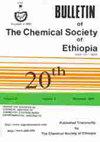一些含有香豆素和1-偶氮香豆素化合物的新型N-(取代)苯酰胺衍生物的设计、合成和细胞毒性活性
IF 1.3
4区 化学
Q3 CHEMISTRY, MULTIDISCIPLINARY
引用次数: 0
摘要
摘要在香豆素和偶氮素衍生物等含氧杂环化合物中,支架已成为开发新药的重要结构基序。香豆素及其衍生物具有多种生物活性,并有报道显示出显著的细胞毒活性。N-(6,8-二取代香豆素-3-酰基)苯酰胺(8a-c)即(3-N-(苯甲酰)氨基香豆素-6-甲基乙酸酯(8a);N-[6-(1-乙酰吡唑-3-基二嗪基)香豆素-3-基]苯甲酰胺(8b);以5-(氯甲基)-2-羟基苯甲醛(3)、5-(吡唑-3-基二嗪基)-2-羟基苯甲醛(4)和5-溴-3-甲氧基-2-羟基苯甲醛(5)与N-苯甲酰甘氨酸(7)为原料,经环缩合反应合成N-(8-甲氧基-6-溴-香豆素-3-基)苯酰胺(8c),收率较高。在无水碳酸钾存在下用氨处理化合物8c,得到N-(5-溴-8-甲氧基-1-偶氮香豆素-3-基)苯酰胺(9)。化合物(9)与乙酸酐乙酰化得到N-(2-乙酰氧基-5-溴-8-甲氧基喹啉-3-基)苯酰胺(10)。测定了N-(取代香豆素)和偶氮素-3-基苯酰胺(8-10)对HepG2细胞株的体外细胞毒活性。此外,对HepG2细胞的DNA流式细胞术研究表明,化合物8a在细胞周期的G1/S阶段表现出阻滞作用,并通过提高G1前阶段诱导细胞凋亡。化合物8a具有明显的微管蛋白聚合抑制作用。关键词:合成,香豆素,偶氮素,药物,细胞毒性化学。Soc。阿比西尼亚人。2023年,37 (4),1003 - 1019 . DOI: https://dx.doi.org/10.4314/bcse.v37i4.16本文章由计算机程序翻译,如有差异,请以英文原文为准。
Design, synthesis, and cytotoxic activity of some novel N-(substituted) benzamide derivatives bearing coumarin and 1-azocoumarin compounds
ABSTRACT. Among oxygen-containing heterocyclic compounds such as coumarin and azacoumarin derivatives, the scaffold has become an important construction motif for developing new drugs. Coumarin and its derivatives possess many types of biological activities and have been reported to show significant cytotoxic activity. N-(6,8-disubstituted coumarin-3-yl)benzamides (8a-c) namely (3-N-(benzoyl) aminocoumarin-6-ylmethyl acetate (8a); N-[6-(1-acetylpyrazol-3-yldiazineyl) coumarin-3-yl] benzamide (8b); N-(8-methoxy-6-bromo-coumarin-3-yl) benzamide (8c), were synthesized via a cyclocondensation reaction of 5-(chloromethyl)-2-hydroxybenzaldehyde (3), 5-(pyrazol-3-yl-diazineyl)-2-hydroxybenzaldehyde (4), and 5-bromo-3-methoxy- 2-hydroxybenzaldehyde (5) with N-benzoylglycine (7), in good yield. Treatment of compound 8c with ammonia in the presence of anhydrous potassium carbonate to yield N-(5-bromo-8-methoxy-1-azocoumarin-3-yl) benzamide (9). Compound (9) was acetylated with acetic anhydride to give N-(2-acetoxy-5-bromo-8-methoxyquinolin-3-yl) benzamide (10). N-(substituted coumarin and azacoumarin-3-yl) benzamides (8-10) were tested for their in vitro cytotoxic activity against (HepG2) cell line. Furthermore, DNA flow cytometry investigation over HepG2 cells indicated that compound 8a demonstrated arrest at G1/S stages of the cell cycle and induction of apoptosis by rising pre-G1 stage. Compound 8a displayed a significant tubulin polymerization inhibition.
KEY WORDS: Synthesis, Coumarin, Azacoumarin, Drugs, Cytotoxicity
Bull. Chem. Soc. Ethiop. 2023, 37(4), 1003-1019.
DOI: https://dx.doi.org/10.4314/bcse.v37i4.16
求助全文
通过发布文献求助,成功后即可免费获取论文全文。
去求助
来源期刊
CiteScore
2.20
自引率
8.30%
发文量
113
审稿时长
6-12 weeks
期刊介绍:
The Bulletin of the Chemical Society of Ethiopia (BCSE) is a triannual publication of the Chemical Society of Ethiopia. The BCSE is an open access and peer reviewed journal. The BCSE invites contributions in any field of basic and applied chemistry.

 求助内容:
求助内容: 应助结果提醒方式:
应助结果提醒方式:


